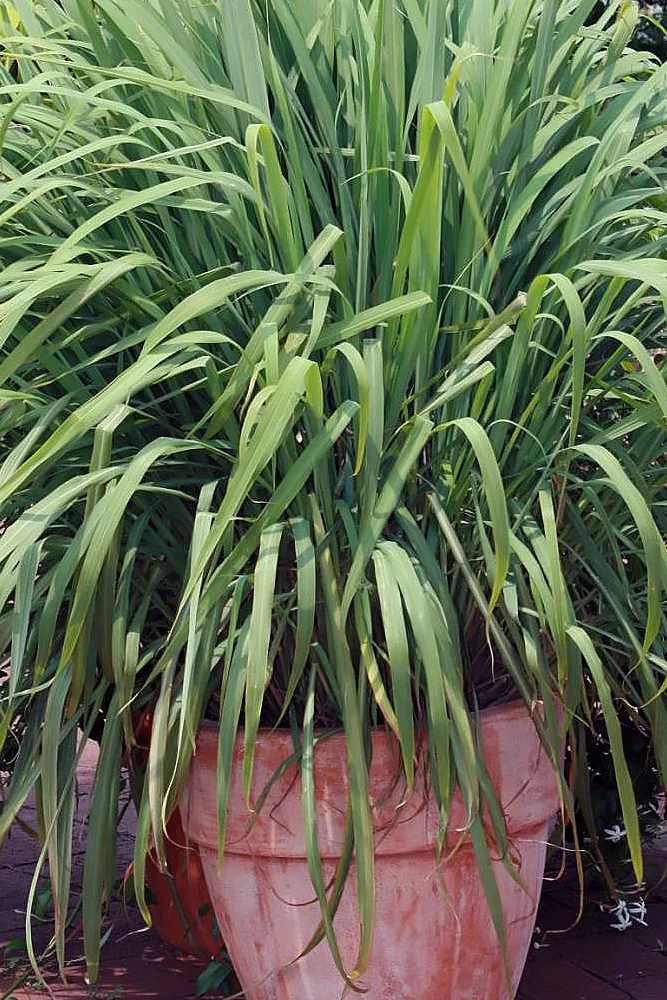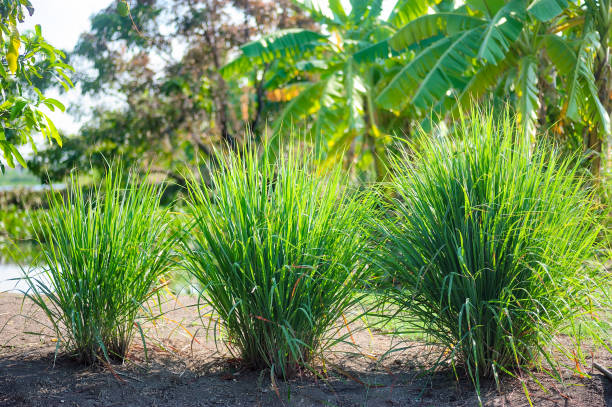Citronella grass is a perennial herbaceous plant belonging to the Poaceae family, whose botanical names are Cymbopogon nardus and Cymbopogon winterianus.
This fragrant and tropical grass is native to Southeast Asia, where it has been traditionally used for its unique fragrance and natural mosquito-repellent properties.
Citronella grass has gained worldwide popularity due to its natural mosquito-repellent properties, making it a favorite in gardens, landscapes, and in the production of citronella oil.
This herb plant is a valuable natural resource that has great potential for various applications in the pharmaceutical, cosmetic, and food industries.
Its distinctive lemon-like aroma has made it a popular choice for aromatherapy and natural body care products. Citronella grass makes it a popular choice for gardens, particularly in areas with a high mosquito population.
The essential oil extracted from citronella grass is rich in natural compounds like citronellal, geraniol, and citronellol, which have therapeutic and insecticidal properties.
Further research on citronella grass may lead to the discovery of new natural products with significant benefits for human health and the environment.
Citronella grass, also known as Cymbopogon nardus, is an all-around and aromatic plant that not only adds beauty to your garden but also repels mosquitoes.
We will explore everything you need to know about planting and caring for citronella grass. Whether you are a seasoned gardener or a complete novice.
| Characteristic | Description |
|---|---|
| Scientific Name | Cymbopogon nardus or Cymbopogon winterianus |
| Common Name | Citronella Grass |
| Family | Poaceae (Grass family) |
| Type | Perennial grass with aromatic properties |
| Fragrance | Strong citrus scent, often described as lemon-like |
| Uses | Insect repellent, culinary (flavoring), ornamental |
| Appearance | Tall, slender stems with long, narrow leaves, forming clumps |
| Climate | Thrives in tropical and subtropical climates |
| Propagation | Seeds or division of existing clumps |
| Growth Habit | Grows in clumps, can reach a height of several feet |
| Culinary Use | Leaves used to add flavor to certain dishes, teas, or infusions |
| Insect Repellent | Essential oil extracted for use in insect repellent products |
| Maintenance | Regular pruning to stimulate growth and enhance oil release |
| Ornamental Value | Cultivated for its ornamental value in gardens and landscapes |
The Right Location for Citronella Grass
When it comes to planting citronella grass, selecting the right location is crucial for its growth and survival. Here are some essential factors to consider:
Sunlight Requirements
Citronella grass thrives in full sun, so choose a location that receives at least 6 hours of direct sunlight each day. This will ensure optimal growth and maximize the plant’s mosquito-repelling abilities.
Soil Conditions
Citronella grass prefers well-draining soil with a pH level between 5.5 and 6.5. If your soil tends to be heavy or clayey, consider amending it with organic matter such as compost or well-rotted manure to improve drainage and nutrient content.
Space and Spacing
Citronella grass can grow up to 5 or 6 feet tall, so make sure you have enough space to accommodate its height and spread. Plant each citronella grass stalk at least 2 feet apart to allow for proper air circulation and prevent overcrowding.
Propagation Methods
Now that you’ve identified the perfect location, it’s time to learn how to propagate citronella grass. There are two primary methods of propagation: by division and from seeds.
Division
Dividing citronella grass is the most common and reliable method of propagation. Follow these steps to propagate your citronella grass through division:
- Dig up an established citronella grass clump.
- Use a sharp knife or garden spade to carefully divide the clump into smaller sections, ensuring that each division has roots attached.
- Replant the divisions into prepared holes in the desired location, ensuring that the crown of each plant is at ground level.
- Water the newly transplanted divisions thoroughly, and continue to keep the soil consistently moist until they establish a strong root system.

Citronella Grass Seeds
If you prefer propagating citronella grass from seeds, here’s what you need to do:
- Collect mature seeds from a healthy citronella grass plant.
- Fill a seed tray or pot with a light, well-draining potting mix.
- Sprinkle the seeds evenly over the surface of the soil.
- Gently press the seeds into the soil, ensuring good seed-to-soil contact.
- Water the seeds lightly to keep the soil evenly moist but not waterlogged.
- Place the tray or pot in a warm location that receives bright, indirect sunlight.
- Germination typically takes around 2 to 3 weeks. Once the seedlings have developed a few leaves, transplant them into individual pots or your chosen garden location.
Citronella grass can easily be grown in a pot,
Caring for Citronella Grass
Now that your citronella grass is planted, it’s time to ensure its proper care and maintenance. Follow these guidelines to keep your plants healthy and vibrant:
Watering
Citronella grass is moderately drought-tolerant once established, but it will benefit from regular watering, especially during hot and dry periods. Water deeply to encourage healthy root growth, and avoid overwatering, which can lead to root rot.
Fertilizing
Citronella grass is not particularly demanding when it comes to fertilization. However, applying a balanced slow-release fertilizer in early spring and midsummer can promote robust growth. Follow the manufacturer’s instructions for the recommended dosage and method of application.
Pruning
Regular pruning is essential to keep your citronella grass looking neat and rejuvenated. In late winter or early spring, trim back any dead or damaged foliage, as well as any overgrown stalks. This will help promote new growth and maintain a compact and tidy appearance.
Pests and Diseases
Citronella grass is generally resistant to pests and diseases. However, occasional issues may arise, such as aphids or fungal diseases.
To combat aphids, gently wash them off the leaves with a strong jet of water or use insecticidal soap if necessary. Should fungal diseases occur, apply a fungicide specifically formulated for grasses, following the instructions provided.
Harvesting Citronella Oil
One of the main attractions of citronella grass is its essential oil, which is commonly used as a natural mosquito repellent. Here’s how you can harvest citronella oil from your plants:
- Wait until your citronella grass has reached maturity, typically after one to two years of growth.
- Select stalks that have a strong lemony fragrance, as these indicate a higher concentration of essential oils.
- Cut the stalks as close to the ground as possible.
- Bundle the stalks together and hang them upside down in a cool, dark, and well-ventilated area.
- Allow the stalks to dry completely, which may take several weeks.
- Once dried, crush the stalks to release the essential oils.
- Store the crushed stalks in an airtight container in a cool, dark place until you’re ready to use the oil as a mosquito repellent.
| The right place to buy Citronella Grass Local Nurseries and Garden Centers: Check with local nurseries and garden centers, as they often carry a variety of ornamental grasses, including Citronella Grass. Staff at these locations can provide advice on cultivation and care. Online Plant Retailers: Explore online plant retailers that ship to your location. Many nurseries offer online purchasing, allowing you to conveniently order Citronella Grass and have it delivered to your doorstep. Botanical Gardens or Arboretums: Visit botanical gardens or arboretums in your area. While they may not always sell plants, staff might provide information on local sources or recommend nurseries. Farmers’ Markets or Plant Sales: Attend local farmers’ markets or plant sales. These events often feature a variety of plants, and you may find Citronella Grass available for purchase. Landscaping Companies: Contact local landscaping companies or garden design professionals. They might know where to source Citronella Grass or may include it in their landscape designs. Community Plant Exchanges: Participate in community plant exchanges or gardening clubs. Fellow gardeners may share or exchange Citronella Grass plants. Specialty Herb or Plant Shops: Some specialty herb or plant shops may carry Citronella Grass due to its insect-repelling properties. |

Types of Citronella Grass
There are several varieties of citronella grass, and two of the most commonly known types are:
- Cymbopogon nardus (Citronella):
- This is the true citronella grass that is most commonly associated with insect-repelling properties. It contains high levels of citronella oil, making it a key ingredient in many insect-repellent products.
- Cymbopogon winterianus (Java Citronella):
- Also known as Java citronella, this variety is often used in the production of citronella oil. It is a hybrid between Cymbopogon nardus and Cymbopogon winter, developed for its higher oil yield.
Citronella Grass vs. Lemongrass
| Characteristic | Citronella Grass | Lemongrass |
|---|---|---|
| Scientific Name | Cymbopogon nardus or Cymbopogon winterianus | Cymbopogon citratus |
| Common Name | Citronella Grass | Lemongrass |
| Uses | Insect repellent (citronella oil extraction), ornamental | Culinary (flavoring in cooking, teas), ornamental |
| Fragrance | Strong citrus scent, lemon-like | Pleasant lemon fragrance, pronounced when crushed |
| Culinary Use | Limited use for flavoring; not as common in cooking | Widely used in cooking, especially in Asian cuisines |
| Growth Habit | Grows in clumps, reaching several feet in height | Grows in tall, slender stalks with a bulbous base |
| Insect-Repelling | Known for insect-repelling properties due to citronella oil | Not as commonly used as a direct insect repellent |
| Other Uses | Cultivated for ornamental purposes | Used in teas, soups, and various dishes in cuisines |
| Culinary Aroma | Primarily known for insect-repelling aroma | Distinct lemon flavor and aroma, used in cooking |
Conclusion
Congratulations! You are now equipped with all the knowledge necessary to successfully plant and care for citronella grass.
Remember to select the right location, propagate using division or seeds, and provide proper care through watering, fertilizing, pruning, and pest management.
So go ahead, give it a try, and enjoy your outdoor space mosquito-free!
People Also Ask
| What is citronella grass used for? Citronella grass is primarily used for the extraction of citronella oil, which is a well-known natural insect repellent. The oil is commonly used in various products such as candles, sprays, and lotions designed to repel mosquitoes and other insects. Additionally, citronella grass is cultivated for ornamental purposes and, to a limited extent, for culinary uses. Is citronella grass the same as lemongrass? No, citronella grass (Cymbopogon nardus or Cymbopogon winterianus) is not the same as lemongrass (Cymbopogon citratus). While they share a citrus fragrance, they are distinct species. Citronella grass is primarily known for its insect-repelling properties, while lemongrass is commonly used in cooking for its lemon flavor. What is the Indian name for citronella grass? Citronella grass is often referred to as “Gandhatrina” in India. The term “Gandhatrina” is associated with its aromatic nature, as “Gandha” means fragrance in Sanskrit. Does citronella grass repel mosquitoes? Yes, citronella grass is known for its insect-repelling properties, particularly against mosquitoes. The citronella oil extracted from the grass is used in various products to create a barrier that helps deter mosquitoes and other insects. While effective to some extent, its efficacy can vary, and it is often used in combination with other methods for mosquito control. Onella grass can easily be grown in a pot, |
